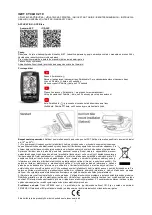
Removing a side-pull brake
➢
Loosen the screws fastening the brake blocks to the brake arms.
The tyre slips through between the brake pads.
Removing a hub gear shifter, roller, drum or coaster brakes
➢
Loosen the screw or the quick release on the brake arm.
Removing the wheel
➢
If your bicycle has a chain gear shifter, change to the smallest rear sprocket. The
removal of the wheel is not hindered by the gear shift mechanism in this position.
➢
If your bicycle is fitted with quick releases, open them (see chapter “Use of the
quick release“, page 7).
➢
If your bicycle is fitted with hexagonal cap nuts, loosen them in an anticlockwise
direction using a size 15 spanner.
➢
Fold the gear change mechanism towards the rear.
➢
Pull the wheel out of the fork.
If this does not work, your bicycle is fitted with a safety mechanism to prevent the
wheel falling out. This will take the form of either retaining lugs or sheet metal
protectors, which grip inside a notch in the wheel receptacle.
➢
In this case, lift up the bicycle a little.
➢
Tap the wheel lightly from above with your hand.
The wheel will fall out.
Removing the tyre and inner tube from the wheel rim
➢
Remove the valve cap and the fixing nut from the valve.
➢
Let the air out of the inner tube.
➢
Place the tyre lever against the lower edge of the tyre opposite the valve.
➢
Lever the side-wall of the tyre over the wheel rim.
➢
Push the second tyre lever between wheel rim and tyre at a distance of
approximately 10 cm from the first.
➢
Lever the tyre with the tyre lever over the wheel rim as often as is necessary until
the entire circumference of the tyre is loosened.
➢
Remove the inner tube from the tyre.
Repairing the inner tube
➢
Pump up the inner tube.
➢
To check where the inner tube is damaged, place it in a bowl of water.
➢
Hold the inner tube under the water.
Air bubbles will rise to the surface from the place where the inner tube is torn
or punctured.
➢
Allow the inner tube to dry.
➢
Roughen up the damaged area of the inner tube with sandpaper.
➢
Apply rubber glue to the area.
➢
Wait a few minutes until the rubber glue is dry to the touch.
➢
Press the rubber patch firmly onto the damaged area.
➢
Allow the rubber patch to dry for a few minutes whilst applying pressure.
Fitting the tyre and inner tube
Avoid foreign bodies getting inside the tyre. Make sure that the inner tube is
free of creases at all times and is not squashed.
➢
Check that the wheel rim tape covers the spoke nipples and is not damaged.
➢
Place one flank of the wheel rim inside the tyre.
➢
Press one side of the tyre completely into the wheel rim.
➢
Pump up the inner tube just enough so that it is round.
➢
Place the inner tube inside the tyre.
➢
Press the tyre over the wheel rim.
➢
Pull the tyre down strongly.
The area already mounted slides into the base of the wheel rim.
➢
Check again that the inner tube is correctly seated.
➢
Push the tyre completely over the wheel rim with the ball of your hand.
➢
Pump up the inner tube to the recommended tyre pressure.
➢
Check the seating of the tyre by means of the control ring on the side
of the wheel rim.
Fitting the wheel
If your bicycle is fitted with quick releases, mount the front wheel so that the
quick release lever is on the opposite side to the chain. In this way, you will
avoid fitting the wheel the wrong way around.
➢
Insert the wheel to the limit and centrally in the dropouts.
➢
Tighten the hub nuts or the quick release.
➢
Hook up the brake cable.
➢
Check that the brake pads contact the brake surfaces.
➢
Carry out a braking test.
36
DCW BedienA_GB UNI.qxd 24.10.2007 12:50 Uhr Seite 36












































